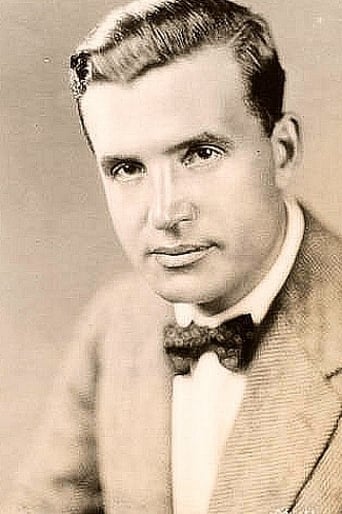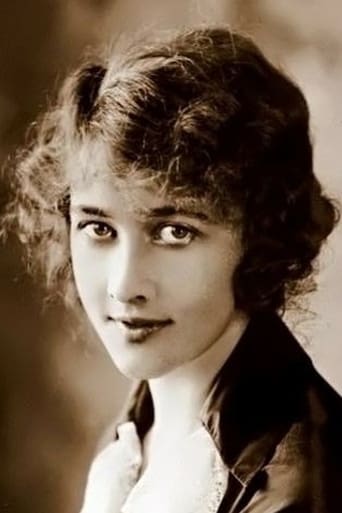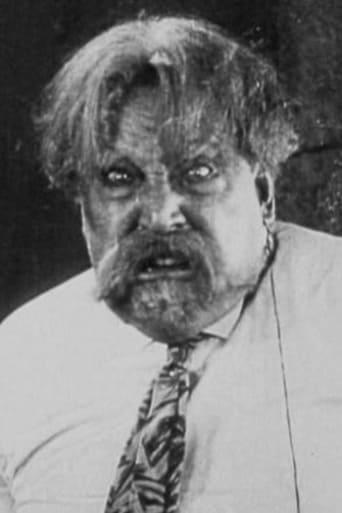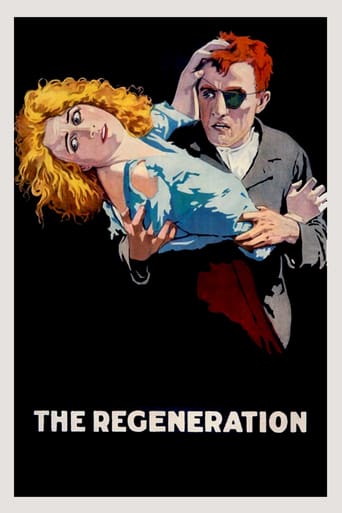
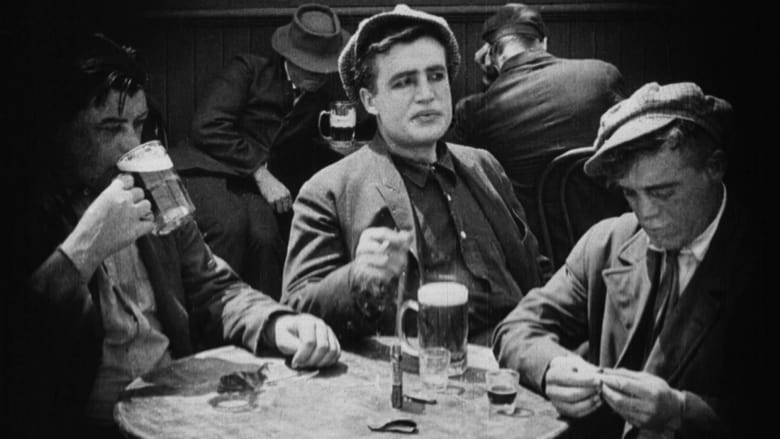
The Regeneration (1915)
At 10 years old, Owen becomes a ragged orphan when his mother dies. Abusive next-door neighbors the Conways take him in, and by 17, Owen has learned that might is right. At 25, he's a career gangster: loitering, gambling and drinking in dens of iniquity. Marie Deering arrives in Owen's area, eager to empower the impoverished, gang-affiliated youth through education. Owen slowly but surely leaves his old life behind, choosing the narrow path- all the while falling in love with Marie. Skinny, who's taken over Owen's role in the gang, reappears to him, spelling trouble.
Watch Trailer
Cast
Reviews
Surprisingly incoherent and boring
Most undeservingly overhyped movie of all time??
Charming and brutal
Instead, you get a movie that's enjoyable enough, but leaves you feeling like it could have been much, much more.
Raule the Director was definitely affected by the terrible tragedy of the Excursion Ship The General Slocum that burned with great loss of life in the East River of NYC in 1904 This film's riverboat seen is directly linked to the disaster of the excursion steamship General Slocum 6/15/1904 along the East River NYC.Over 1000, mostly women and children, lost their lives due to criminal negligence. At the time of the making of this movie the tragedy was still fresh in the minds of most Americans. People may want to examine info available about this tragedy on the internet. It was NYC's largest loss of life in one event until the 9/11 tragedy.
What a super movie - it had thrills, suspense and a very surprising finish, you have to keep reminding yourself it is over 96 years old!!! Anna Q. Nilsson may well have been one of the first film stars to freelance. She was a beautiful Swedish actress who had been working at Kalem for four years. Unfortunately her salary had not increased (much) and she had just divorced her husband who happened to be Kalem's leading actor.Raoul Walsh esteemed her talents as an actress enough for him to cast her in "Regeneration", his first major directorial assignment and a sensational crime movie based on Owen Kildare's popular play, "My Mamie Rose", which was said to be autobiographical. Walsh, a disciple of D.W. Griffiths, may even have surpassed his master in some of the scenes from this movie. The crowd scenes at Grogans captured the color and vibrancy of the city's melting pot of people. Outside of a few scenes in a Bowery mission it was all filmed on the streets of New York, including scenes on the Hudson River.The film begins with young Owen, due to the death of his mother, being taken in by his neighbours, the Conways, a rough couple who soon familiarize Owen with tough, unforgiving tenement life. Owen (Rockcliffe Fellows) is eventually hardened to the "might is right" way of the streets and by his mid twenties is the leader of a tough street gang. The new D.A. vows to stamp out the gangsters but bows to pressure from butterfly socialite Marie (Nilsson) who longs to see a gangster close up. He takes her to Grogans, the local gangster haunt but is involved in a scuffle and Marie's real distress catches Owen's attention. He breaks up the fight but the incident awakens Marie's better self and she soon finds herself running a settlement house in the heart of the gangster district. The day everyone looks forward to is the annual treat, a day of pleasure on a large boat. The fire on board the boat showed Walsh's superb handling of crowds - people madly running everywhere, the plunging into the river, the frantic scramble to get to a boat that eventually collapses through overloading and the end title that declares "All the kiddies were saved"!!! Apparently Walsh hired thugs from Hell's Kitchen to round up some extras from the Bowery and when there weren't enough women he offered some men extra money to dress up as women and it made for a vivid and realistic sequence when they all jumped into the water. William Fox was so impressed that he raised Walsh's salary to $800 a week!!There is even a graphic (for 1915) scene of drug use. A woman flees to the settlement begging that someone rescue her baby from the dwelling she shares with her drug addicted husband. Owen, who is not involved with the settlement, is deemed the man for the job and when he goes to the room and finds the man in a groggy state, by rescuing the baby his salvation begins. Children are symbols of innocence and purity - Owen, as a child, was seen as a loving little boy who was corrupted by the adult couple who took him in and in the fire sequence, Owen runs back to the boat to save two little girls. Griffith's influence is seen in the pathos, when Marie realises Owen has secretly helped a friend, "Skinny", to avoid a serious charge although in Owen's favour, he wants nothing more to do with "Skinny" - it was as a favour to repay a childhood debt.Interspersed between a brutal near rape scene are various Griffith inspired titles, very flowery, some with biblical quotations.
I'd been meaning to return to this film, "Regeneration", for some time and finally did after seeing it on the double feature DVD with "Young Romance" (1915). This review is replacing the one I wrote over 5 years ago. I was overly hasty in my previous comment I think now, and I want to elaborate on some things and make some new comments. Moreover, only 2 out of 13 people found my prior comment useful, so that's a good indication that I should try to at least write and express my opinions better. I considered this film less than average the last time I saw it (whether for a film from 1915 or for a film from anytime), and I still consider it such. Others, however, clearly consider it a good to excellent picture, and some of them have made good arguments to that effect in their IMDb comments, and so that has also encouraged me to revisit "Regeneration".The best part of this film is probably, as others have said, its realism in using locals as extras and for minor parts, its location shooting and that, especially through the scenes of violent parents I think, convincingly demonstrates the cycle of violence in such a slum. Most of the photoplay, however, concerns itself with the plot of the regeneration of supposed gangsters. There are quite a few title cards that setup the picture to be a gangster-crime film, of which there had already been some in the US ("The Musketeers of Pig Alley" (1912) and "Alias Jimmy Valentine" (1915) are the most accessible ones today); but, here, they're only gangsters in so far as they gather together and do little and rough up someone they don't like occasionally. There's no on screen impetus for a politician to want to crackdown on these "gangsters", at least not before he seeks to do so but doesn't (that plot line is dropped abruptly and never much develops). Near the end, there are some rather unprovoked outbursts that are especially violent by the Skinny character, but there's still no sense of any organized crime.The storyline becomes more akin to a William S. Hart Western and similar hackneyed formulas: Owen either lazily drinks and smokes and gathers idly with his friends or gets into some fights (what Hart did at saloons in the first parts of his films, for comparison) until he falls in love with the white, virginal Christian woman (often a reformer and from a higher class, as here) and so begins his regeneration, becoming Christian and civilized.The acting here isn't special either, although the leads do OK enough for back then. Anna Q. Nilsson, in particular, would have a decent career in the silent era, including playing the pure woman for Hart's Western "The Toll Gate" (1920), and continued acting long after that. The only consistent problem with the acting was the tendency of Nilsson and Rockliffe Fellowes to turn away from other characters and stare at nothing to project that they're thinking or are conflicted. The uncredited actor (despite appearing to have the third most screen time) who plays the little fellow at least stares at Fellowes and Nilsson in some queer adulation.The attempted rape climax, the rescue attempt, in addition to further influence for the Marie Deering character are taken straight from the formulas of D.W. Griffith, which makes sense since this film's director Raoul Walsh was fresh from working on Griffith's "The Birth of a Nation", released earlier in 1915. Griffith had mastered this formula from his multiple last-minute-rescue shorts at Biograph and brought the pure woman, the attempted rape of her and her rescue together in "The Birth of a Nation". The editing in the climax of "Regeneration" and its constant crosscutting throughout, use of match cuts, irises and so on demonstrate further the influence of Griffith, but, in "Regeneration" most of it's choppier, clumsily derivative and often rushed and lacking, as in the rescue and denouement.The good woman and regeneration plots and other themes probably have more ancient roots dating to the stage, as well. There are a couple other seeming influences on smaller parts of "Regeneration" I'd like to comment on, though. The fire scene on the boat recalls similar sensational sequences rather irrelevant to the rest of the plot from earlier Danish silent films. "The Great Circus Catastrophe" (Dødsspring til hest fra cirkuskuplen) (1912), which involved a fire in a hotel, and "Atlantis" (1913), which involved a ship sinking if little fire, come to mind. "Regeneration" was based on an autobiography and its theatrical adaptation, but it also seems plain to me that it's based on preexisting movie conventions. On film technique, another aspect that stands out are some brief dolly shots, which were likely inspired by "Cabiria", which used comparatively boring, slow dolly shots. Dolly shots had been exploited in cinema since at least 1903, but "Cabiria" seems to have briefly popularized it and influenced their use in some subsequent films.Nevertheless, in "Regeneration", there's the realism of the surroundings in contrast to the shallow development and formulaic nature of the narrative: a gangster's world without gangsters, real people surrounding movie clichés. The film techniques and style are not original, but are lesser imitations.(Note: There's considerable bleeding and deterioration to the surviving print.)
Rather than repeat what others have written, I'd like to comment on how this film managed to get into circulation.The only known print of the film was found in the basement of a building in Montana in 1976. Preserved (and not too soon given the deterioration seen in the middle of the film), it was part of a series of films shown during the New York Film Festival representing titles which had recently (1978) been saved. I remember seeing all of them; they included Lillom (recently issued on DVD in the Murnau/Borzage box and worth seeing), and The Letter (with Jeanne Eagles, which blew everyone away). It is a miracle that films still turn up in such a manner even this late in the game. Most films from this time period have long ago turned into flammable dust (they started to deteriorate as early as the thirties), and it is particularly fortunate that "Regeneration" is now among the living. Despite its crudities, it feels like a documentary of the seedier elements of New York, and it still works its magic; it has matured very well. Given that we can see how the streets of New York really looked almost 100 years ago, the film may play better than it did back then. Most of the people in this film are not actors, they are real people, and that is what we reacted to when we saw this back in the seventies. Additionally, the film is a real window into the transitional period when the one-reeler had turned into a longer, more ambitious feature. As a first feature for Walsh, this film is really extraordinary when we consider that the tools of film-making were still crude (the comments on the editing of the film are correct. However, the abruptness plays better on the big screen). Even more, the film also reminds us that the numerous features made between 1914 and 1920 included some real gems that are gone forever, and cannot be re-evaluated. How many really good actors and directors are known in name only because their work has disappeared?I consider this one of the finest examples of an early silent feature, and one of the landmark films of the silent era. It is an illustration of how the director of that time found his or her way, made mistakes and had chances to improve. It shows how filmmakers were taking the vocabulary used by Griffith and some European filmmakers to expand the techniques of storytelling to hold an audience's interest for an hour's worth of entertainment.A must-see if you are interested in silent films.
